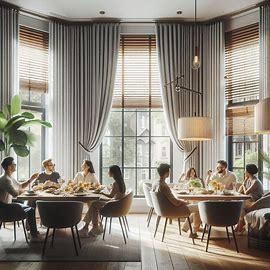
Introduction
Window treatments are more than just a decorative element—they play a crucial role in the ambiance, lighting, and functionality of your dining space. Whether your dining room is a formal entertaining space or a casual family area, selecting the right treatments can enhance its overall appeal. This guide offers expert advice on choosing the right window treatments for dining rooms, covering style, function, privacy, and light control.
1. Understanding the Function of Dining Room Window Treatments
Balancing Light and Privacy
One of the primary purposes of window treatments in the dining room is to manage natural light while maintaining privacy. The dining area often serves multiple purposes: entertaining guests, hosting dinner parties, or even working from home. That means finding the perfect balance between openness and seclusion is essential.
Key Considerations:
- Do you need to block direct sunlight?
- Is privacy a concern for evening meals?
- Would you like a treatment that adapts throughout the day?
Light-filtering shades, layered drapes, and adjustable blinds are all excellent solutions depending on your needs.
Enhancing Aesthetics
Beyond function, window treatments contribute significantly to the dining room’s visual identity. From soft sheers that add elegance to bold patterns that make a statement, your choice can define the room’s personality.
Style Tips:
- Match treatments with furniture and wall color
- Consider ceiling height for curtain length
- Opt for textured fabrics to add warmth
2. Types of Window Treatments Ideal for Dining Rooms
Drapes and Curtains
These are classic choices that can transform any dining space. Drapes and curtains are available in a wide variety of fabrics, colors, and lengths.
Pros:
- Excellent light and privacy control
- Adds a luxurious touch
- Available in blackout and sheer varieties
Example Use:
- Floor-to-ceiling velvet drapes in jewel tones for a formal dining area
- Linen sheers for a breezy, informal space
Blinds and Shades
Blinds and shades offer a more modern or minimalist look. They are practical, easy to operate, and highly customizable.
Types of Shades to Consider:
| Shade Type | Best Feature |
|---|---|
| Roman Shades | Elegant folds; fabric variety |
| Roller Shades | Sleek design; easy to maintain |
| Cellular Shades | Energy-efficient; soft appearance |
| Bamboo Shades | Eco-friendly; organic texture |
Shutters
Interior shutters provide a tailored, architectural feel to dining rooms. These are especially great in homes with a coastal, farmhouse, or colonial aesthetic.
Advantages:
- Long-lasting and durable
- Excellent for privacy and light control
- Adds value to the home
Layered Treatments
Combining two or more types of treatments—like sheer curtains with blackout shades—can offer the best of both worlds.
Why Layer?:
- Flexibility in light control
- Enhanced insulation
- Elevated style
3. Matching Window Treatments with Dining Room Styles
Formal Dining Rooms
For traditional or formal dining spaces, window treatments should exude elegance and sophistication. Think heavy drapes, layered valances, and luxe fabrics like silk or velvet.
Ideas:
- Richly colored, lined draperies with tassels or fringe
- Layered treatments with Roman shades beneath curtains
- Ornate curtain rods in bronze or gold finishes
Casual Dining Areas
In a more relaxed setting, simplicity and comfort are key. Lighter fabrics, natural textures, and neutral tones work well.
Suggestions:
- Cotton or linen curtains in earthy hues
- Woven wood shades for rustic charm
- Café curtains that cover only the lower half of the window
Contemporary Dining Rooms
Modern dining rooms benefit from sleek, streamlined window treatments that enhance the architectural features of the space.
Modern Options:
- Motorized roller shades
- Floor-length panels in neutral tones
- Minimalist cellular shades
4. Choosing Fabrics, Colors, and Patterns
Fabric Choices
The type of fabric you choose will determine how well the treatment functions and how it looks.
| Fabric Type | Best For |
| Velvet | Formal, elegant rooms |
| Linen | Light-filled, airy spaces |
| Cotton | Versatile and easy to maintain |
| Silk | Luxurious appearance (requires care) |
Color Considerations
Color affects both the mood and visual space of the room. Darker colors create drama and intimacy, while lighter shades promote openness.
Color Tips:
- Match with wall or accent colors for cohesion
- Use contrasting hues to create focal points
- Choose warm tones for a cozy vibe
Patterns and Textures
Patterns can add personality to your dining room, but balance is key. Large prints can overwhelm small spaces, while subtle textures enhance visual interest without overpowering the room.
Recommended Patterns:
- Geometric prints for modern styles
- Florals or damasks for classic looks
- Stripes for a touch of elegance
5. Practical Considerations and Maintenance
Cleaning and Upkeep
Window treatments should be easy to maintain, especially in areas where food and drink are common. Consider materials that resist stains or are machine washable.
Low-Maintenance Options:
- Polyester blends
- Roller and cellular shades
- Faux wood blinds
Energy Efficiency
The right window treatments can help regulate indoor temperatures, reducing heating and cooling costs.
Energy-Saving Choices:
- Thermal-lined drapes
- Honeycomb shades (cellular)
- Layered curtains with insulating properties
Safety and Accessibility
For families with children or pets, cordless or motorized options are safer and more convenient.
Safe Options Include:
- Cordless Roman or cellular shades
- Motorized roller shades with remote control
- Plantation shutters with no hanging cords
Conclusion: Create a Dining Room You’ll Love
Choosing the right window treatments for dining rooms involves a blend of aesthetics, function, and personal style. Whether you’re after the elegance of layered drapes, the simplicity of roller shades, or the natural appeal of woven wood blinds, the right choice can dramatically elevate your dining experience.